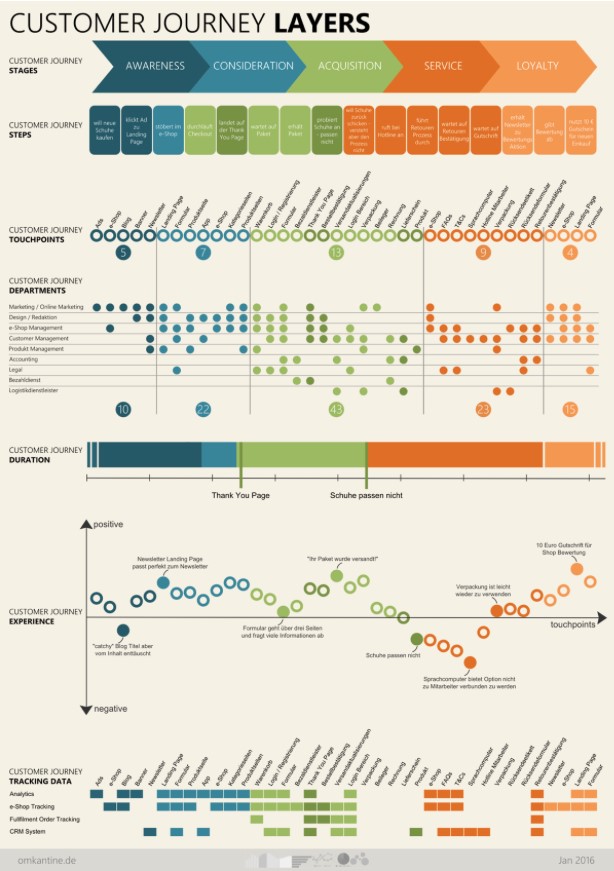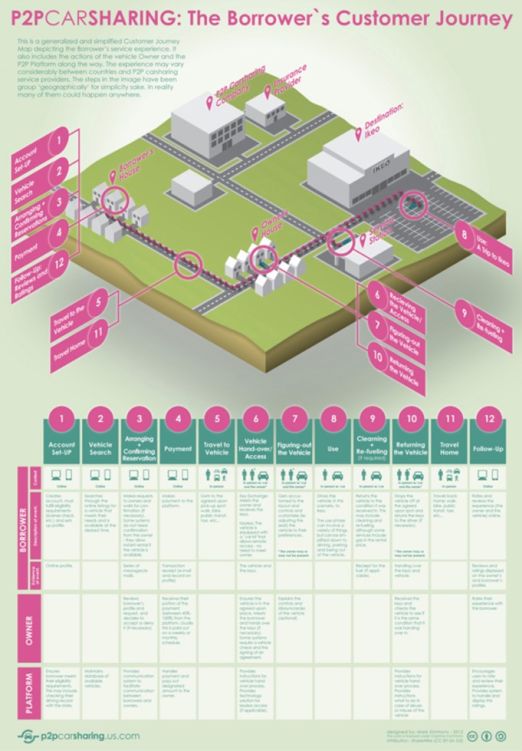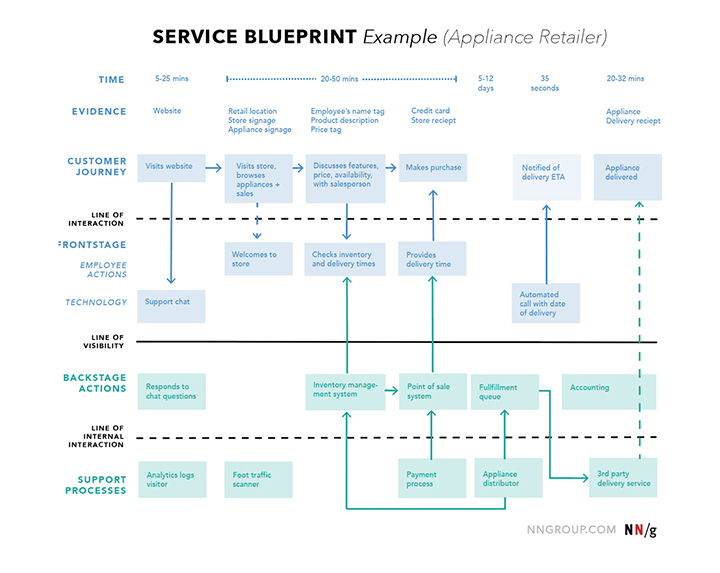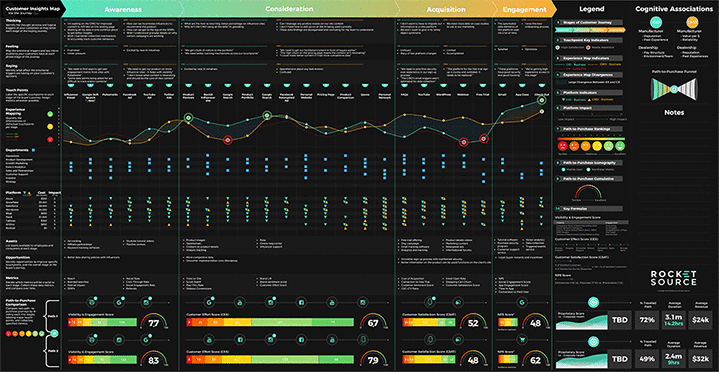10 interesting customer journey examples
What kind of customer journey descriptions are there? What would be the best customer journey description? What should be considered when considering path description perspectives and visualization? Our strategists Julia Isoniemi and Heini Nuutinen took ten customer journey descriptions under a magnifying glass and listed the pros and cons of different descriptions.

here are many different customer journey descriptions in the field, and it can be difficult to get to grips with them. As the name implies, the most important recurring core of customer journey photography is the customer and the customer perspective on the experience being described. Various path descriptions have often been made as a tool to support communication within the organization. The purpose of the path can also be to help prioritize development or operational measures or, for example, to plan marketing content.
Therefore, the way the customer journey is described must be chosen according to its future use.
Here, we evaluate different approaches to customer journey perspectives and visualizations. We have summarized the strengths and weaknesses of each customer journey description below. Browse this blog post to get a comprehensive view of the different types of customer journey descriptions.
Customer journey example 1: Description emphasizing customer emotion and collaboration within the organization

STRENGTHS
• Clear and visually pleasing to look at, even though containing a lot of information
• Visualize the peaks and deepest lows of emotions, not just the emotion written
• Connects the stages of the path to the internal departments of the organization that are producing the experience. This makes it easier to plan, engage and commit the implementation of development
• Visualizes the average length of different phases
• Indicates the most important data sources at different stages.
WEAKNESSES
• Generally better suited as a room painting than PowerPoint.
• Does not describe the customer’s pain points at different stages.
• Does not describe the target state of the experience or the most important development points.
Customer journey example 2: Experience map

STRENGTHS
- Systematic and structural description that combines actions, thought processes and emotions.
- Visualizes the cyclicality and complexity of actions (on-going, linear, non-linear arrow descriptions)
- Visualizes the experience with current-level bars and utilizes a more detailed breakdown (enjoyment, relevance, helpfulness) in valuation.
- Honestly examines how relevant or helpful the brand itself is to consumers at any given time.
- Brings the most important development points into the same view customer journey, and clearly guides to improve the identified entities.
WEAKNESSES
• Requires deepening and examination. In this way, it can be easy to skip the detailed customer path, i.e. leave it in a drawer for your own work.
• The path requires an auxiliary framework for more detailed definition and planning of development entities.
• Does not give an overall score on the status of phase-specific experiences: at a quick glance, it’s challenging to see which phase of development requires the most prioritization.
Customer journey example 3: Visual process infographic

STRENGTHS
• A distinctive, impressive visualization of the touchpoints of the customer journey.
• Illustrates well the complexity and scope of the customer journey.
• Especially suitable for supporting communication when the goal is to visualize the magnitude and complexity of the customer experience.
• Helps different parts of the organization to point out places that they themselves can influence.
WEAKNESSES
• A bit confusing, at least for digital scanning, may therefore remain in a desk drawer if you are not used to it.
• Does not contain more detailed descriptive information or valuation of different touch points, i.e. not directly suitable for prioritizing development measures.
Customer journey example 4: Description visualizing service points

STRENGTHS
• An illustrative and approachable description that uses real-world elements (service desks) to support the message.
• Perfectly illustrates the customer journey, where the experience is influenced by several parties (borrower, owner, platform).
• Works best as a poster in a close work environment and as an easily understandable whole.
WEAKNESSES
• Not suitable for digital review.
• Demands more from planning the development process, because the description does not take a structural stand on, for example, emotions, pain points, prioritization or many other areas.
Customer Journey Example 5: Description emphasizing customer’s experiences and observations

STRENGTHS
• Effectively opens a view into the customer’s inner feelings.
• Simple and concise.
• Describes the elements of a good customer experience with their meanings as well as the ingredients of a poor customer experience.
• Helps to communicate the customer’s mindset in the service process to service providers.
WEAKNESSES
• Leaves to guess, for example, the digital touchpoints of the customer journey and the impact of previous brand experience.
• Requires a lot of supporting material around it in the development process.
• Ignores all traditional sections of the customer journey description, although it introduces a new and insightful way of presentation.
Customer Journey Example 6: Service Blueprint Description

STRENGTHS
• Helps to conceptualize the experience production process from backstage to customer encounter. • Works especially for optimizing back-end processes.
• Shows concrete tasks per team.
• Facilitates the implementation of thinking in different teams, underlines the importance from the perspective of one’s own work.
• Clarifies the role of marketing also after the purchase.
WEAKNESSES
• Can grow into a massive task if the roles of teams in the stages of the journey are described too precisely.
• Does not comment on the prioritization or criticality of development actions.
• It is not a so-called traditional customer journey description that could be used for strategic, comprehensive development.
Customer Journey Example 7: User Flow Description

STRENGTHS
• A simple path that still recognizes that there are various routes on the customer journey.
• Helps to concretize choice situations and possible pain points.
• Suitable for analyzing website visits, for example.
WEAKNESSES
• Is not a so-called traditional customer journey description suitable for strategic development.
• Ignores all the most common parts of the customer journey description.
• Requires a lot of additional material to support prioritized
development.
Customer Journey Example 8: Marketing Automation Flows

STRENGTHS
• A concrete, implementable, very operational view for the marketer.
• Visualizes message sending paths.
• Suitable for an operational implementer of automation.
WEAKNESSES
• Does not suit as a development view in the same way as “real” customer journey descriptions.
• Not recommended for anything other than operational chaining of automation messages.
Customer Journey Example 9: Experience Wheel Description

STRENGTHS
• An extremely simplifying and emotion-experience emphasizing description.
• Helps to communicate, especially at the beginning of internal collaboration within the organization, the customer’s perspective on the experience.
WEAKNESSES
- • The description remains superficial, even though it can clearly show the different stages in the process.
• Focuses on describing only the current state and does not include the target state in the description.
• Descriptions of customer pain points are missing.
Customer Journey Example 10: Situation Room Dashboard

STRENGTHS
• A comprehensive and possibly real-time situation picture of the customer journey’s operation.
• A dashboard view that enables tracking of development change compared to benchmarks or goals.
• A dream for an analytical and result-focused marketer.
WEAKNESSES
- With all love: a hell of a machine that leaves the faint-hearted gasping for air.
• Requires a lot of background definition and analytics before it is possible to form a situation room description.
As you can see from the examples, there are likely as many ways to describe a customer journey as there are customers in general. Therefore, the best customer journey is built by shaping together, not just mechanically filling in the blanks of a form. Excessive mystification should not be created around customer journeys.
When you want to build a customer journey description, take an external sparrer to support the process. You ensure a sufficiently objective approach and an efficient process description. With the help of a professional, it can be a matter of a few weeks at best – and your customer journey can already be ready!